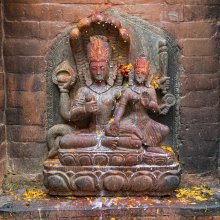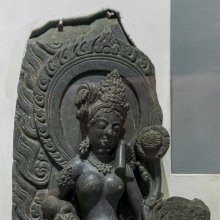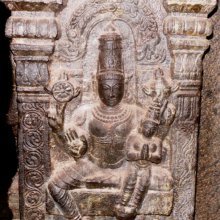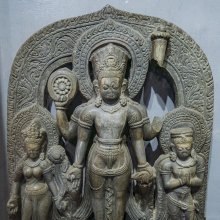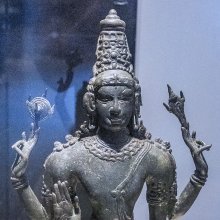Shrilakshmi, Śrīlakṣmī, Shri-lakshmi: 1 definition
Introduction:
Shrilakshmi means something in Hinduism, Sanskrit. If you want to know the exact meaning, history, etymology or English translation of this term then check out the descriptions on this page. Add your comment or reference to a book if you want to contribute to this summary article.
The Sanskrit term Śrīlakṣmī can be transliterated into English as Srilaksmi or Shrilakshmi, using the IAST transliteration scheme (?).
Images (photo gallery)
In Hinduism
Vaishnavism (Vaishava dharma)
Source: Brill: Śaivism and the Tantric Traditions (vaishnavism)Śrīlakṣmī (श्रीलक्ष्मी) refers to one of the Teachers mentioned in the guruparaṃparā of Vedānta Deśika’s Yatirājasaptati.—The poem’s first ten verses create the context for the exaltation of Rāmānuja. This context is the lineage of teachers (guruparaṃparā) who preceded him and are listed in the first eight verses of the poem in the following order: Nārāyaṇa, Śrī-Lakṣmī, Viṣvaksena, Nammāḻvār, Puṇḍarīkākṣa (Uyyaṅkoṇṭār), Śrīrāmamiśra (Maṇakkāl Nampi), Yāmuna (Āḷavantār) and Mahāpūrṇa (Periya Nampi). In verse 11 Rāmānuja is addressed, for the first time, with the phrase “Lord of the Ascetics” (patiṃ yatīnām).

Vaishnava (वैष्णव, vaiṣṇava) or vaishnavism (vaiṣṇavism) represents a tradition of Hinduism worshipping Vishnu as the supreme Lord. Similar to the Shaktism and Shaivism traditions, Vaishnavism also developed as an individual movement, famous for its exposition of the dashavatara (‘ten avatars of Vishnu’).
See also (Relevant definitions)
Partial matches: Lakshmi, Shri.
Full-text (+13): Shri, Lakshmi, Natyamatri, Vibhuti, Sarvakama, Daridra, Daridrarnava, Narayana, Vishvaksena, Uyyankontar, Sarvakamaprada, Sadhanopaya, Nammaḻvar, Alavantar, Tarani, Kamaprada, Yamuna, Mahapurna, Manakkal Nampi, Shriramamishra.
Relevant text
Search found 22 books and stories containing Shrilakshmi, Śrīlakṣmī, Śrī-lakṣmī, Shri-lakshmi, Srilaksmi, Sri-laksmi; (plurals include: Shrilakshmis, Śrīlakṣmīs, lakṣmīs, lakshmis, Srilaksmis, laksmis). You can also click to the full overview containing English textual excerpts. Below are direct links for the most relevant articles:
Brihad Bhagavatamrita (commentary) (by Śrī Śrīmad Bhaktivedānta Nārāyana Gosvāmī Mahārāja)
Verse 1.2.30 < [Chapter 2 - Divya (the celestial plane)]
Verse 1.3.67 < [Chapter 3 - Prapañcātīta (beyond the Material Plane)]
Verse 2.2.156 < [Chapter 2 - Jñāna (knowledge)]
Jnaneshwari (Bhavartha Dipika) (by Ramchandra Keshav Bhagwat)
Verse 3.43 < [Chapter 3 - Karma-yoga]
Verse 16.2 < [Chapter 16 - Daivasura-sampad-vibhaga-yoga]
The Agni Purana (by N. Gangadharan)
Chapter 237 - A hymn in praise of Goddess Śrī (Lakṣmī) for the sake of success
Chapter 177 - Vows observed on the second lunar day
Ramayana of Valmiki (by Hari Prasad Shastri)
Chapter 109 - Rama’s Departure for the Mahaprasthana < [Book 7 - Uttara-kanda]
Srila Gurudeva (The Supreme Treasure) (by Swami Bhaktivedanta Madhava Maharaja)
Lakṣmī-Devī as stated by Śrī Madhvācārya < [Chapter 1.5 - Back to Home Village]
Nagara-Saṅkīrtana < [Chapter 2.19 - The Concluding Transcendental Pastimes]
Sthayi-bhava never changes < [Chapter 1.2 - Śrīla Gurudeva’s Pūrvāśrama]
Chaitanya Bhagavata (by Bhumipati Dāsa)
Verse 3.9.8 < [Chapter 9 - The Glories of Advaita]
Verse 1.14.28 < [Chapter 14 - The Lord’s Travel to East Bengal and the Disappearance of Lakṣmīpriyā]
Verse 2.13.254 < [Chapter 13 - The Deliverance of Jagāi and Mādhāi]
